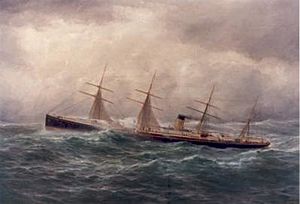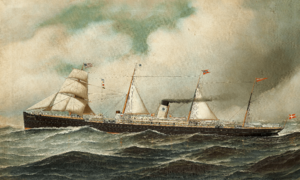SS Celtic (1872) facts for kids

Celtic, by George Parker Greenwood
|
|
Quick facts for kids History |
|
|---|---|
| Name | SS Celtic |
| Namesake | Celtic Sea |
| Owner | White Star Line |
| Route | Liverpool - Queenstown (Cobh) - New York City |
| Builder |
|
| Yard number | 79 |
| Laid down | as Arctic |
| Launched | 18 June 1872 |
| Completed | 17 October 1872 |
| Maiden voyage | 24 October 1872 |
| Fate | Sold to the Thingvalla Line of Copenhagen on 6 April 1893 |
| Name | SS Amerika |
| Owner | Thingvalla Line of Copenhagen |
| Route | Copenhagen - Christiania (Oslo) - Christiansand - New York City |
| Acquired | 6 April 1893 |
| In service | 27 May 1893 |
| Out of service | September 1897 |
| Fate | Scrapped at Brest in 1898 |
| General characteristics | |
| Class and type | Oceanic-class ocean liner |
| Tonnage | 3,867 gross register tons |
| Length | 437.2 ft (133.3 m) |
| Beam | 40.9 ft (12.5 m) |
| Installed power | Steam |
| Propulsion | Single screw |
| Sail plan | Four masts (rigged for sail) |
| Speed | 14 kn (26 km/h; 16 mph) |
| Capacity | 166 1st- and 1,000 3rd-class passengers |
| Notes | Iron construction, single funnel |
The SS Celtic was a large passenger ship called an ocean liner. It was built for the White Star Line company by shipbuilders Harland and Wolff in Belfast. The Celtic was the first of two White Star ships to have this name. It was also the last of six similar ships called the Oceanic-class liners.
Contents
Choosing the Ship's Name
The ship was first going to be named Arctic. However, there was another ship called Arctic that sank in 1854. To avoid bad luck, the White Star managers decided to change the name. They chose Celtic instead.
The Celtic's Journey
Starting Her Career
The Celtic was one of six ships built for the White Star Line. These ships helped the company deliver mail across the Atlantic Ocean. Five ships were needed for a weekly service, and the sixth ship was a spare. The Celtic was bigger than the first four ships in its class.
The Celtic was 437 ft 2 in (133.25 m) long and 40 ft 9 in (12.42 m) wide. It used steam power from 12 boilers to move through the water. The ship was built by Harland and Wolff in Belfast. It was officially launched into the water on June 8, 1872.
The Celtic began its first journey from Liverpool in October 1872. In January 1873, it hit something in the Atlantic Ocean. The ship lost its propeller blades. Another ship, the SS Gaelic, had to tow it to Queenstown, County Cork (now Cobh) in Ireland.
In January 1877, the Celtic rescued people from a sinking American ship called the Island Belle. The captain of the Celtic, Benjamin Gleadell, was thanked by the President of the United States, Ulysses S. Grant. Later, in 1879, the Celtic's propeller came off again. The ship had to use its sails to get back to Queenstown.
In 1880, Edward Smith joined the Celtic's crew. He later became a very famous captain for the White Star Line. He was also the captain of the RMS Titanic. In November 1881, the Celtic rescued another crew from a ship called the Alice.
Collision with the Britannic
On May 19, 1887, the Celtic crashed into another White Star ship, the Britannic. This happened in thick fog about 350 miles (560 km) east of Sandy Hook, New Jersey. The Celtic was heading to New York City with 870 passengers. The Britannic was on its way to Liverpool with 450 passengers.
The Celtic hit the Britannic almost straight on. Its front part went 10 feet (3 m) into the side of the Britannic. The Celtic then bounced off and hit two more times. Six passengers on the Britannic died right away. Six more were missing, likely washed overboard. No one on the Celtic was hurt.
Both ships were badly damaged. The Britannic had a big hole below the water. People on board started to panic and rushed for the lifeboats. The Britannic's captain helped calm everyone down. Women and children got into the lifeboats first. After some lifeboats left, they realized the Britannic would not sink. Many lifeboats were called back. The other lifeboats went to the Celtic.
The two damaged ships stayed together overnight. Other ships joined them the next morning. Together, they slowly made their way into New York Harbor. An investigation later found both captains were partly to blame for the crash. They were told to be more careful in fog. It was also suggested that ships should have separate paths across the Atlantic to prevent future crashes.
End of Her Service
In 1892, the White Star Line decided to sell the Celtic. In 1893, a Danish company called the Thingvalla Line bought it. They renamed the ship Amerika. It began sailing between Copenhagen and New York.
However, the ship was too big for the number of passengers on that route. It was not a good business success. The Amerika was only used for eight trips during busy times. In 1898, the ship was sold and taken apart for scrap metal.
See also
- RMS Celtic (1901) - a later ship of the White Star Line with the same name


